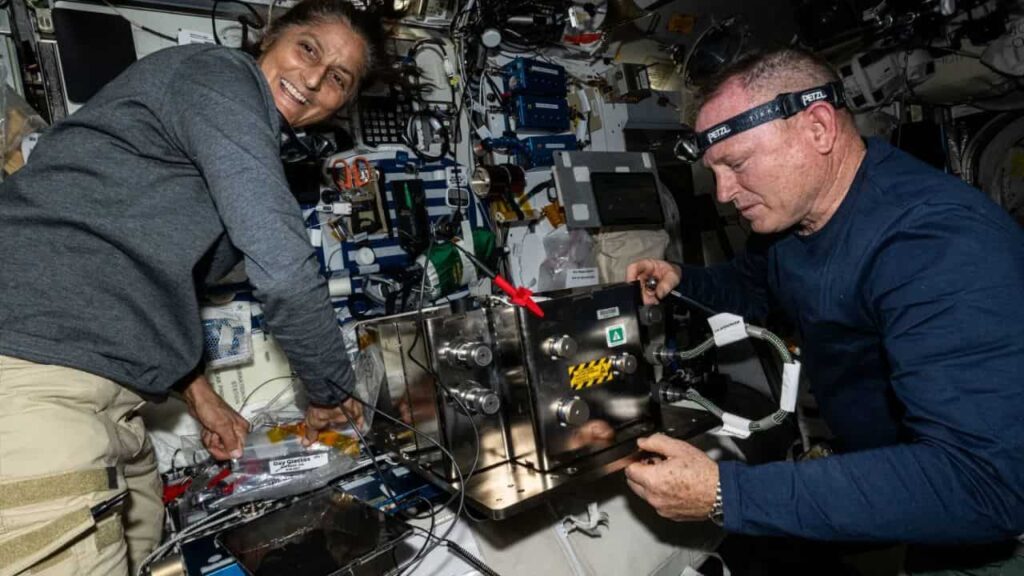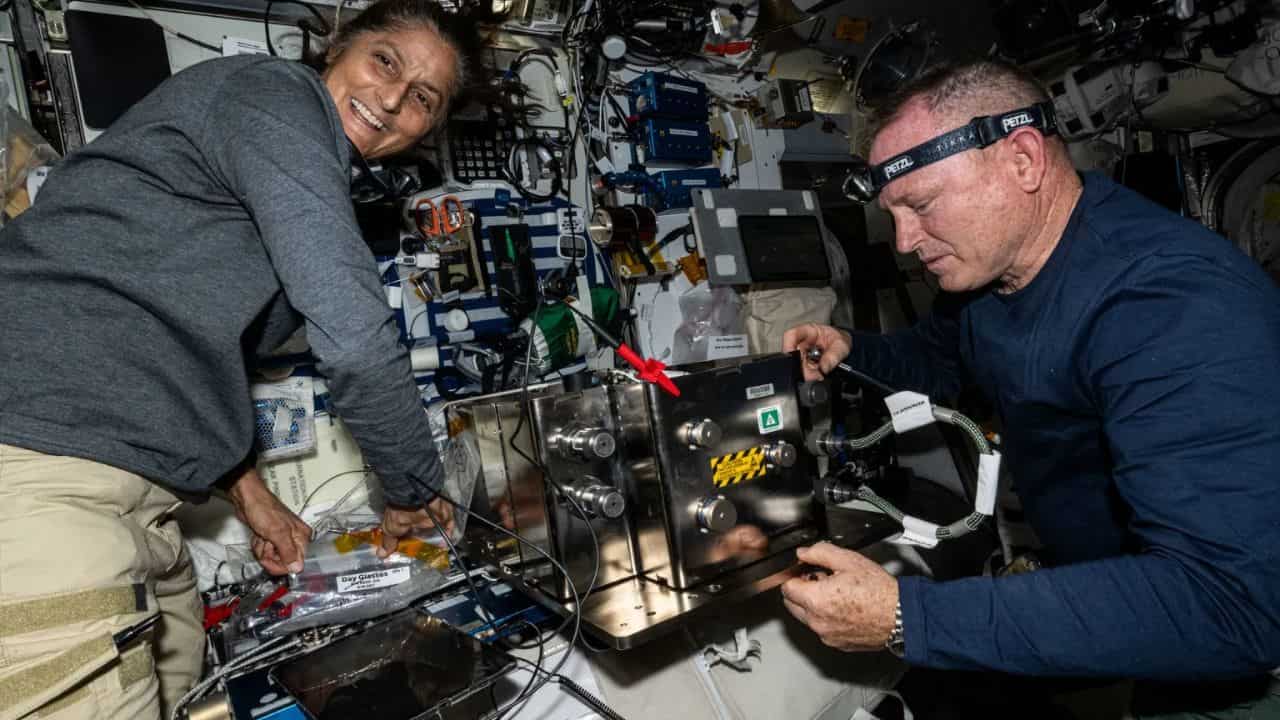NASA astronauts, Butch Wilmore, Suni Williams, ISS news conference, NASA Earth-to-space call, Expedition 71/72, SpaceX Dragon Crew-9 mission, Boeing Starliner mission, NASA live broadcast, space exploration updates, International Space Station news
NASA astronauts Butch Wilmore and Suni Williams will discuss their mission aboard the ISS during an Earth-to-space call on September 13. Learn about their experiences, current research, and the future of space exploration.

NASA Astronauts to Discuss Mission from International Space Station: Insights into Expedition 71/72
On Friday, September 13, 2024, NASA astronauts Butch Wilmore and Suni Williams will participate in a live news conference aboard the International Space Station (ISS). This event, which will allow media and the public to hear firsthand from astronauts currently in low Earth orbit, highlights NASA’s continued efforts to engage the public with the cutting-edge advancements in space exploration. The call, set for 2:15 p.m. EDT, will be streamed live on NASA+, the NASA app, and the agency’s website. It promises to offer unique insights into their mission aboard the ISS, the latest developments in space exploration, and their experiences on the Starliner and SpaceX Dragon spacecraft.
NASA’s Earth-to-Space Call: Connecting Astronauts with the Public
NASA’s Earth-to-space calls are an important tool for keeping the public and media connected to the latest developments in human space exploration. These events allow people around the world to hear directly from astronauts in space, gaining insights into their work, the challenges they face, and their personal reflections on space travel.
On September 13, astronauts Wilmore and Williams will join this tradition. The call comes at a pivotal moment in their mission as part of the Expedition 71/72 crew. Having been aboard the ISS for over three months, the astronauts will discuss their scientific research, the future of space exploration, and the evolution of international collaborations on the ISS.
The Journey of Butch Wilmore and Suni Williams to the ISS
NASA astronauts Butch Wilmore and Suni Williams launched aboard Boeing’s Starliner spacecraft on June 5, 2024, for its first crewed flight, arriving at the ISS on June 6. Their mission marked a significant milestone in NASA’s Commercial Crew Program, which seeks to collaborate with private companies to provide safe and reliable transportation to the space station.
Wilmore, an experienced NASA astronaut, has a rich history of spaceflight, with multiple missions to his name, including two previous trips to the ISS. His extensive experience and leadership are crucial to the success of this mission.
Suni Williams, another veteran astronaut, is well-known for her time aboard the ISS and her previous records for spacewalks and spaceflight duration among female astronauts. Her knowledge, experience, and dedication make her a key player in the ongoing success of NASA’s long-term presence in space.
However, after successfully launching aboard the Starliner, NASA made a strategic decision to return the spacecraft uncrewed to Earth. This decision was part of NASA’s ongoing efforts to ensure the safety and reliability of its spacecraft before fully operationalizing crewed missions. As a result, Wilmore and Williams are now slated to return to Earth aboard the SpaceX Dragon spacecraft as part of the NASA SpaceX Crew-9 mission in February 2025.
Life Aboard the International Space Station
The International Space Station, orbiting approximately 250 miles above Earth, is a floating laboratory and one of humanity’s greatest technological achievements. The ISS serves as a hub for scientific research, technology demonstrations, and international collaboration. Since its inception, astronauts from across the globe have conducted thousands of experiments aboard the station, advancing our understanding of space, life sciences, and even Earth’s climate.
For astronauts like Wilmore and Williams, daily life aboard the ISS consists of conducting scientific experiments, maintaining the spacecraft, and ensuring the smooth operation of its systems. They are part of an international crew tasked with advancing humanity’s presence in space while learning how to live and work in microgravity environments.
Wilmore and Williams, as part of the Expedition 71/72 crew, are engaged in research that will shape the future of space exploration. Their work involves everything from studying the effects of long-term spaceflight on the human body to testing new technologies that will enable humans to travel further into space, including missions to Mars.
During the Earth-to-space call, these astronauts will likely discuss the scientific experiments they are currently working on, including investigations into how the microgravity environment of space affects everything from biological organisms to materials science. The unique conditions aboard the ISS offer scientists an opportunity to study processes that are impossible to replicate on Earth, and the knowledge gained from these experiments will have profound implications for both space exploration and life on our planet.
NASA’s Commercial Crew Program and Its Role in Space Exploration
The journey of Wilmore and Williams to the ISS aboard Boeing’s Starliner spacecraft is part of NASA’s larger Commercial Crew Program, which aims to partner with private companies to develop spacecraft capable of transporting astronauts to and from the space station. The program is a critical component of NASA’s strategy to expand humanity’s presence in space, as it seeks to commercialize low Earth orbit while focusing on deep space exploration.
The Commercial Crew Program represents a shift in how NASA approaches spaceflight. Instead of relying solely on government-built spacecraft, NASA now works with private companies like Boeing and SpaceX to develop spacecraft that can carry astronauts to the ISS and beyond. This collaboration not only increases the frequency of crewed missions but also lowers the cost of space travel, opening up new possibilities for the future of human spaceflight.
Boeing’s Starliner spacecraft, which carried Wilmore and Williams to the ISS, is one of the two vehicles developed under NASA’s Commercial Crew Program, alongside SpaceX’s Dragon spacecraft. The successful launch of Starliner marked an important milestone in the program, although NASA’s decision to return the spacecraft uncrewed reflects the agency’s commitment to safety and continuous improvement.
Despite the change in return plans, the success of the Starliner mission highlights the progress being made in commercial space travel. With Wilmore and Williams scheduled to return aboard SpaceX’s Dragon spacecraft in 2025, the future of NASA’s commercial space endeavors continues to look promising.
SpaceX Crew-9 and the Astronauts’ Return
When NASA astronauts Butch Wilmore and Suni Williams return to Earth in February 2025, they will do so aboard the SpaceX Dragon spacecraft as part of NASA’s SpaceX Crew-9 mission. SpaceX has played a crucial role in NASA’s recent crewed missions, with its Crew Dragon spacecraft providing reliable transportation to and from the ISS.
The partnership between NASA and SpaceX is a testament to the success of the Commercial Crew Program, and the Crew Dragon spacecraft has become a key element in NASA’s human spaceflight program. The spacecraft’s ability to carry astronauts safely to the ISS, coupled with its advanced technology and safety features, has made it a reliable vehicle for NASA’s continued exploration of space.
The Crew-9 mission, which will bring Wilmore, Williams, and two other crew members back to Earth, will mark yet another successful collaboration between NASA and SpaceX. As NASA looks to the future, missions like Crew-9 will play a critical role in maintaining the ISS as a hub for scientific research and international cooperation.
NASA’s Public Engagement and the Importance of Media
NASA’s decision to broadcast the Earth-to-space call with Wilmore and Williams is part of the agency’s broader mission to engage the public and foster a sense of excitement about space exploration. Events like these allow people around the world to connect with astronauts in space, hear their stories, and learn about the incredible work being done aboard the ISS.
The media’s role in covering these events is crucial, as it helps bring space exploration into the public consciousness. Journalists who participate in the Earth-to-space call will have the opportunity to ask questions, gaining firsthand insights from astronauts who are living and working in space. This interaction provides valuable context for the scientific advancements being made aboard the ISS and helps inspire future generations of space explorers.
NASA’s commitment to public engagement is also reflected in its use of various streaming platforms. The agency has embraced digital technology, allowing people to watch live broadcasts of space missions on NASA+, the NASA app, and the agency’s website. This accessibility ensures that space exploration remains a shared experience, inspiring people of all ages to learn more about the cosmos and humanity’s role in exploring it.
Conclusion: An Exciting Look into the Future of Space Exploration
As NASA astronauts Butch Wilmore and Suni Williams prepare to participate in their Earth-to-space call on September 13, the world will be watching and listening. Their mission aboard the ISS, their journey aboard Boeing’s Starliner, and their eventual return on SpaceX’s Dragon spacecraft are all part of NASA’s larger vision for the future of space exploration.
By engaging with the public through live broadcasts and media participation, NASA continues to inspire curiosity and innovation. As we look to the future, missions like Expedition 71/72 remind us of the incredible potential of human space exploration and the role that international collaboration, scientific research, and commercial partnerships will play in shaping the next frontier.
The Earth-to-space call with Wilmore and Williams will offer a rare glimpse into life aboard the ISS, highlighting the hard work and dedication of NASA’s astronauts as they push the boundaries of what is possible in space.
Read More
